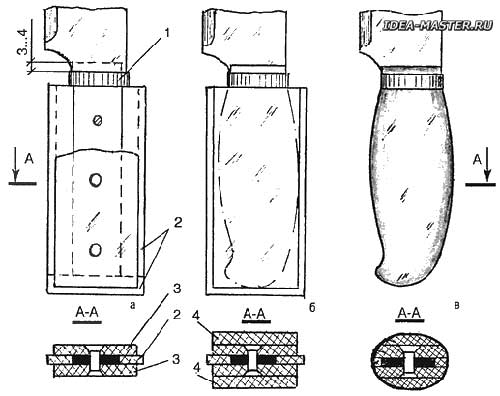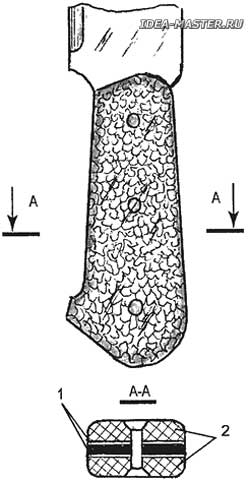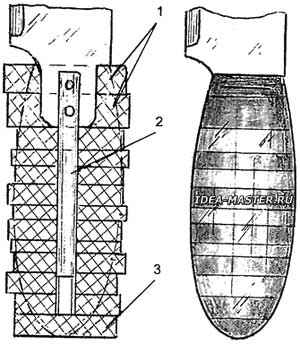Plexiglass crafts: paper cutting knives, homemade knives with set handles made of plexiglass
Plexiglass crafts
The simplest crafts made of plexiglass are flat products: silhouette figures, rulers, protractors, squares, patterns, paper cutting knives, cutting boards, etc. Cutting boards are especially good for their hygiene and original appearance.
Paper cutting knives. Figure 1 shows drawings of several paper cutting knives. The blades of these knives are quite simple in configuration and it is not very difficult to cut them out of plexiglass sheets using a cutter and a ruler. The refinement of the silhouette curves is carried out with an emery stone and cylindrical rods with an emery skin. After the knife blade has been given the necessary shape, the blade is sharpened (on one or both sides of the blade), the surface is prepared for polishing, and then polished. If the knife needs to be made more spectacular, its handle is decorated with false multicolored or monochrome details, and the blade is decorated with the same details and holes. So, Figure 1, a shows a knife with a double-edged blade and pads on the handle. The section B-B shows that the overlays are flat with rounded edges. The color of the overlays is chosen and tried on, like a tie to a shirt, only not according to fashion, but according to the harmonious combination of colors and silhouettes of details.
 Fig. 1. Options for paper cutting knives. |
In Fig. 1, b, the overlays in the cross section have the shape of segments, and three holes are made in the blade of the knife. The sharpening of the blade is one-sided. In both cases, the blades of the knives are made of transparent colored plexiglass, and the overlays are made of plexiglass with a blind color.
The blade of the knife (Fig. 1, d) is made of a sheet of plexiglass with a dark (deaf or transparent) color, and the overlay is made of plexiglass of milk color. The leaves and flowers are cut from transparent green and red plexiglass. For the knife in Fig. 1, d, plexiglass of a thick milky color is selected. And green, red and blue plexiglass went to the buds. The canvas is made of dark, black plexiglass, and the overlays of yellow with a dull color are characteristic of the knife shown in Fig. 1, E. At the knives (fig. 1, w, w, i) the canvases are made of thick milky or light plexiglass, and the overlays are made of dark and deaf plastic.
Knife handles. Making handles for real kitchen knives is a little more complicated. Knife blades are suitable for both old and (what is better) new. I repeat, the manufacture of new knives is preferable, since the part of the canvas reserved for the handle is easy to «program» for the design of the latter. And when «upgrading» an old knife, you have to adapt a new handle instead of the old one, which is not always convenient. Figure 2 shows three operations performed when creating a handle from overhead plates. It is clear, first they make a knife blade with a rectangular end under the handle. In this case, it makes sense to decorate the handle with a crimping ring, for which it is best to try to pick up a stainless steel tube, preferably with thin walls. It is easy to give the ring the shape of an oval, rectangle, circle, polyhedron. At the very least, silver and gold wedding rings are suitable if love is over and the marriage has broken up. Do not waste the same good!
 Fig. 2. The sequence of manufacturing the handle from the overhead plates for a kitchen knife: 1 — ring; 2 — inserts; 3 — inner lining; 4 — outer lining. |
After polishing, the ring is put on the end of the cloth, intended, of course, for the handle. Two internal overhead plates are cut out with an allowance for the ring and for processing. The upper ends of both plates are adjusted so that they fit tightly into the ring, protruding beyond its limits by 2...3 mm. Next, the resulting assembly is clamped in a vice and three rivet holes are drilled in it, countersinking the edges of the rivet holes with countersunk heads. After installing the rivets, their protruding parts are ground flush with the plates.
 Fig. 3. Rainbow handle: 1 — stanyol (more precisely aluminum foil); 2 — plexiglass plates. |
In the same way, upper linings are made, for which plexiglass with a thick dark color is selected, so that rivets do not peek through these plates. The outer pads are glued to the inner ones and clamped with clamps or in a vice, leaving them so for two days. After assembling the handle, cracks may remain in it, for example, from the sides, which is observed if the dimensions of the part of the canvas for the handle are smaller than the dimensions of the handle itself (this usually happens). To seal these cracks, plexiglass plates are selected (their thickness is equal to the thickness of the canvas) and glued into these cracks. On the outer plate of the handle, its contour is drawn in its final form (Fig. 2, b), after which, along the contour with an emery circle, a hacksaw, a file, everything superfluous is removed from the assembly-gluing, after which the handle is ground and polished. Figure 2, b shows the finished handle.
Homemade kitchen knives with handles (made of plastics), shimmering with all the colors of the rainbow, are often found at the marketplaces. This color game is achieved by using... bean wrappers from sweets. Such a wrapper is first crumpled to get a lot of kinks with micro-edges that send light bunnies in all directions. Then the wrapper is smoothed (not until the kinks completely disappear) and inserted between the canvas and transparent plexiglass linings (Fig. 3), after which the linings are connected to the knife blade with rivets. In order for the color iridescence to be iridescent, they pick up bean wrappers with colored drawings. Handles made of one-color «silver» (or «gold») resin also look quite impressive.
 Fig. 4. Typesetting handles (simple): 1 — upper plates (made of deaf plexiglass); 2 — steel rod; 3 — lower plate (without hole). |
In its own way, typesetting handles are interesting, made up of multi-colored pieces-plexiglass plates (Fig. 4). You can make such a handle with a knife with a shank (part of the canvas on which the handle is attached) of any shape. But if the shank for the dial handle is short, and sometimes it is conceived as such, then a steel rod with a diameter of 4...6 mm is welded or riveted to such a short shank. For more convenient fastening of plates on the rod, at the end of the latter, a thread with a length of 10...15 mm is cut. Any cuttings of plexiglass will be suitable as typesetting plates, as long as they «pass» in size. In all plates, except the last two, holes are drilled for the rod, and in those upper plates that fall on the shank, the drill bits or milling cutters develop more holes for the shank. In the penultimate two plates, threads are cut to screw them onto the rod. The plates are lubricated with glue, strung on a rod and clamped (sealed), screwed onto the rod with threaded plates. The lowest plate (it is without a hole) is glued after a week. Next, the handle is processed on an emery stone, sanded with skins and fragments of ordinary window glass, polished.
When making plates with holes, it should be borne in mind that in transparent plexiglass, the walls of the drilled hole acquire a milky color, which does not add beauty to the product, since after polishing the product, the walls of the hole begin to peek through transparent plexiglass. Therefore, it is desirable to iron the hole from the inside with a red-hot rod, as a result, the milky matte color of the walls will disappear and the hole will even turn into an element decorating the handle. I also advise you to make the upper and lower set plates from plexiglass with a thick or dull dark color to mask the traces of connections (rivets, threads). By the way, the typesetting pen made of transparent plexiglass creates the illusion of a product made of precious minerals with its play of light.
But for overhead handles (see Fig. 2) plexiglass with a dull color is preferable, creating smooth blurred transitions between layers of plexiglass, which gives the handle the appearance of a product made of marble, granite, porcelain, horn.
 Fig. 5. Typesetting handle (with plates arranged obliquely). |
A typesetting pen made up of plates arranged obliquely looks more elegant. Here, the handle is first formed by gluing the plates with an offset relative to each other, as shown in Fig. 5. The glued blank of the handle should be put aside for about a month, and only after this period start processing. First, we cut the top of the workpiece along the «K-L» plane perpendicular to the longitudinal axis of the knife. Then, a protrusion is made on the top of the workpiece — a seat for the ring. Now it remains to strengthen the shank of the knife in the handle blank. If the shank is short enough, it is heated and pressed into the workpiece, for which the corresponding hole is usually formed in the latter. Or, having made a larger hole, a shank is inserted into it and the hole is filled with epoxy resin.
If you have formed the upper part of the handle from plates of deaf plexiglass, but no traces of the handle attachment will be visible through it, which is why its appearance will only benefit.
For a long shank, you will have to make a round or slit-shaped hole in the handle. For the latter, first drill a hole of the desired depth, and give it the appropriate shape with a red-hot rod or plate. Next, a ring is put on the ledge, the contour of the handle is drawn on the workpiece and all excess sandpaper is removed. After grinding and polishing, epoxy resin is poured into the slot, the shank is inserted, the protruding glue is removed and the knife is left in an upright position for 5...6 hours (until the resin hardens).
All materials of the section «Ideas for the master»
| Share this page on social networks: |
